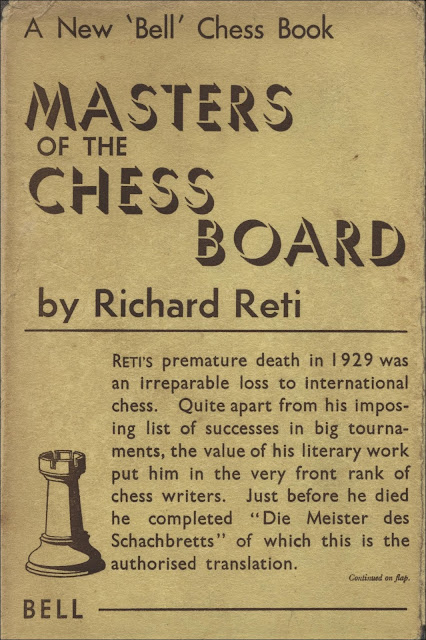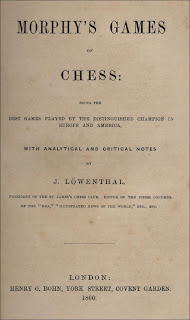Wormald, who died in December 1876 aged 42, makes clear in his Preface that he had presented the book for publication almost exactly as it left Staunton's hands, indicating that the work was virtually complete at the time of the author's death.
Staunton died on 22nd June 1874, aged 63 or 64, while working at his desk, but there are varying accounts of what he was working on. In Howard Staunton; the English World Chess Champion by R. D. Keene and R. N. Coles, St. Leonards on Sea, 1975, page 25 states that "a heart attack took him ..... as he sat in his library chair working on the manuscript of a further chess book, which proved sufficiently advanced with the help of editing by R. B. Wormald, to appear in 1876 as Chess: Theory and Practice"
However, H. J. R. Murray, on page 518 of an article in the BCM for December 1908, stated that Staunton died while seated at his desk and writing another of the series of papers on Unsuspected Corruptions of Shakespeare's Text which he had been contributing to the Atheaneum.
The fascinating book Notes on the life of Howard Staunton, by John Townsend, Wokingham 2011, quotes, on page 167, from a letter written by Staunton's wife to her husband's friend James Halliwell: "You will I am sure be very grieved to hear that my poor husband died yesterday quite suddenly. I found him in his chair quite dead with an un-finished letter before him. An hour before when seen he appeared in his usual health."
The industrious Staunton was probably working on all three.
The industrious Staunton was probably working on all three.
It is unclear exactly when Staunton wrote Chess: Theory and Practice, but probably over a number of years right up to his death. Townsend's book has many extracts from Staunton's correspondence during the latter years of his life, but there is not a single mention of his final chess work. However, von der Lasa, writing in The City of London Chess Magazine for February 1875, quotes from a letter from Staunton dated 29th November 1873: "I have myself been engaged on a work of the same nature [as Bilguer's Handbuch]... Many sheets of it were in type this time last year, when I was attacked by my old complaint, ... and was compelled to lay it aside."
Howard Staunton, by D. N. L. Levy, Nottingham 1975, a book which concentrates on Staunton's writings, but without an index or even a contents page, gives, on page 142, the text of a letter from Staunton to Mr. Fraser dated February 17th, 1874, which includes the following: "My Chess work goes on very slowly; though it is nearly all written and a good deal in type. I broke down last year through ill-health. I have never gained the ground then lost."
Chess: Theory and Practice is another extraordinary contribution to chess literature by Staunton. The first 29 pages are devoted to Some Account of the Origin and History of the Game of Chess. This includes descriptions of the most important chess works from the 15th to the 19th centuries, perhaps written with the assistance of his friend J. Rimington Wilson, to whom this book was dedicated. This is followed by a comprehensive primer, and an extensive analysis of the openings, over 400 pages, with many illustrative games. Nevertheless, Dr. Tim Harding claimed on page 246 of British Chess Literature to 1914, Jefferson 2018, that the book "made little impact now that Staunton was no longer alive."
The production of this book is all the more meritorious considering Staunton's other literary commitments at the time, his very poor physical and mental state of health, and his nomadic existence during the final years of his life. This is all evident from the many extracts from Staunton's letters in Townsend's book.
One final matter from Chess: Theory and Practice; pages 22/23 give details of a book by Fra. Antonio das Neves which appeared after his death, in 1647. This is Arte do Liberal Loguo do Axadres, a manuscript which was never printed, according to van der Linde (Geschichte volume II page 171).
_____________________________________________________________
My Love Affair with Tchigorin, by A. E. Santasiere, Dallas, Texas 1995.
Anthony Santasiere died aged 72 in 1977 leaving some of his manuscripts to Ken Smith who published this book some 18 years later. Smith included the following short note on the last but one page of the book:
Santasiere's passion for chess is evident from his Introduction which is written in his typically romantic style; the word "love" or its derivatives appear 30 times.
The 100 games are clearly displayed with many diagrams, and are annotated by Santasiere borrowing heavily from previous commentators.
The short biography of Santasiere, presumably written by Ken Smith, reveals that he was the twelfth of thirteen children of Italian and French parents, had drawn games with Edward Lasker, Marshall and Janowski at Lake Hopatcong in 1923, and was chess champion of Florida in his 60's. Santasiere was also an accomplished poet, musician, artist and novelist.
While Santasiere was not the most highly respected author, this is a useful addition to the sparse literature on Chigorin in English.
_______________________________________________________
One of the best known posthumous chess books is A Short History of Chess by H. J. R. Murray, Oxford 1963.
Written by Murray 1917, the typescript was found among his papers following his death in 1955. The Clarendon Press at Oxford published this shortly after they had reprinted Murray's 900 page A History of Chess, which was first issued in 1913. The 138 pages of A Short History of Chess are far more digestible than its predecessor, which expends over 800 of the 900 pages on pre 1500 chess history.
Murray's typescript took the story of chess from its beginnings up to 1866, and additional chapters were added to A Short History of Chess by B. Goulding Brown covering 1866 to 1945, and by H. Golombek on Modern Times.
_____________________________________________________
The Modern Two-Move Chess Problem, by Comins Mansfield and Brian Harley, London 1958.
A note on the half title explains that Brian Harley, who died in 1955 aged 71, had designed this book as a primer to introduce beginners to the fascinating charm of the chess problem.
The explanatory Introduction is followed by 24 pages containing 100 problems composed by Comins Mansfield, and 100 pages of solutions with commentary by Brian Harley.
A few more another time.





















































